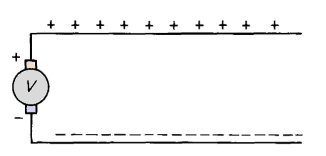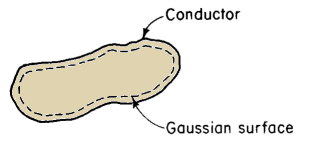| Capacitors, Magnetic Circuits, and Transformers is a free introductory textbook on the physics of capacitors, coils, and transformers. See the editorial for more information.... |

|

Home  Capacitance and Related Effects Capacitance and Related Effects  Charge Within A Conductor Charge Within A Conductor |
|||||||






|
|||||||
Charge Within a Conductor That has a Static Charge
Consider two wires insulated from each other. One is connected to the positive side of the d-c source, and the other to the negative side of the d-c source as shown in Fig. 2-8.
The upper wire receives a positive charge, and the lower wire a negative charge. These charges are static, i.e., they are not in motion once they are established, and there is no difference of potential from one end of a wire to the other. In other words the electric field intensity E within the wires is zero. If the wires were # 18 AWG copper, a size commonly used in lamp cord, a field intensity E along the wires of only one v per m would produce a current of about 50 amp. Therefore, when there is no current within a conductor the electric field intensity E everywhere within a conductor is zero. Accordingly, it can be shown by means of Gauss's theorem that the static charge is on the surface of a conductor. Figure 2-9 shows a conductor that carries a static charge. The broken line represents a Gaussian surface an infinitesimal distance inside the actual conductor surface. Since the charge
on the conductor is static, there is no flow of current within the conductor. The electric field intensity E must therefore be zero within the Gaussian surface. Hence from Eq. 2-20
This means that there is no charge within the Gaussian surface and the entire static charge must be on the surface of the conductor. This is true also for a hollow conductor. Therefore a charge outside of the conductor does not produce an electric field inside the hollow. However, a charge inside the hollow will produce an electric field that follows from Gauss's theorem outside the conductor.
|
|||||||
Home  Capacitance and Related Effects Capacitance and Related Effects  Charge Within A Conductor Charge Within A Conductor |
|||||||
Last Update: 2011-02-16




